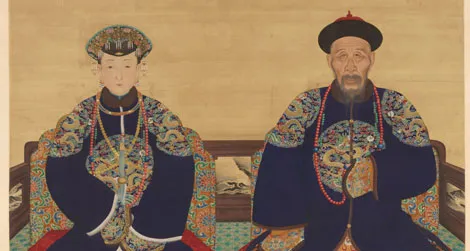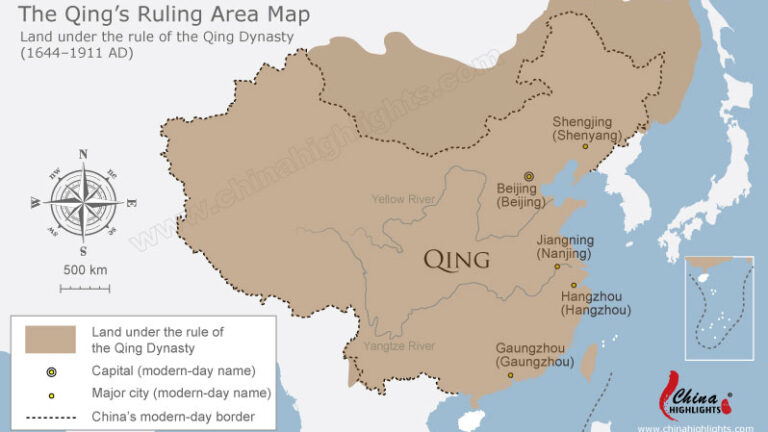The Qing dynasty, officially the Great Qing ([tɕʰíŋ]), was the last dynasty in the imperial history of China. It was established in 1636, and ruled China proper from 1644 to 1912, with a brief restoration in 1917. It was preceded by the Ming dynasty and succeeded by the Republic of China. The multiethnic Qing empire lasted for almost three centuries and assembled the territorial base for modern China. It was the largest Chinese dynasty and in 1790 the fourth largest empire in world history in terms of territory. With a population of 432 million in 1912, it was the world’s most populous country at the time.
In the late sixteenth century, Nurhaci, leader of the House of Aisin-Gioro, began organizing “Banners” which were military-social units that included Manchu, Han, and Mongol elements. Nurhaci united clans to create a Manchu ethnic identity and officially proclaimed the Later Jin dynasty in 1616. His son Hong Taiji declared the Qing dynasty in 1636. As Ming control disintegrated, peasant rebels conquered Beijing in 1644, but the Ming general Wu Sangui opened the Shanhai Pass to the armies of the regent Prince Dorgon, who defeated the rebels, seized the capital, and took over the government. Resistance from the Ming loyalists in the south and the Revolt of the Three Feudatories delayed the complete conquest until 1683. The Kangxi Emperor (1661–1722) consolidated control, maintaining Manchu identity, patronizing Tibetan Buddhism, and relishing the role of Confucian ruler. Han Chinese officials worked under or in parallel with Manchu officials. The dynasty also adapted the ideals of the tributary system in asserting superiority over peripheral countries such as Korea and Vietnam, while extending control over Tibet and Mongolia.

Men of China’s Qing Dynasty Chose Trophy Wives to Flaunt Their Wealth
The height of Qing glory and power was reached in the reign of the Qianlong Emperor (1735-1796). He led Ten Great Campaigns that extended Qing control into Inner Asia and personally supervised Confucian cultural projects. After his death, the dynasty faced changes in the world system, foreign instrusion, internal revolts, population growth, economic disruption, official corruption, and the reluctance of Confucian elites to change their mindsets. With peace and prosperity, the population rose to some 400 million, but taxes and government revenues were fixed at a low rate, soon leading to fiscal crisis. Following China’s defeat in the Opium Wars, European powers led by Great Britain imposed “unequal treaties”, trading privileges, extraterritoriality and treaty ports under foreign control.
The Taiping Rebellion (1850–1864) and the Dungan Revolt (1862–1877) in Central Asia led to the death of over 20 million people, from famine, disease, and war. The Tongzhi Restoration of the 1860s brought vigorous reforms and the introduction of foreign military technology in the Self-Strengthening Movement. Defeat in the First Sino-Japanese War of 1895, led to loss of suzerainty over Korea and cession of Taiwan to Japan. The ambitious Hundred Days’ Reform of 1898 proposed fundamental change, but the Empress Dowager Cixi (1835–1908), who had been the dominant voice in the national government for more than three decades, turned it back in a coup.
In 1900 anti-foreign “Boxers” killed many Chinese Christians and foreign missionaries; in retaliation, the foreign powers invaded China and imposed a punitive Boxer Indemnity. In response, the government initiated unprecedented fiscal and administrative reforms, including elections, a new legal code, and abolition of the examination system. Sun Yat-sen and revolutionaries debated reform officials and constitutional monarchists such as Kang Youwei and Liang Qichao over how to transform the Manchu Empire into a modern Han Chinese nation. After the deaths of the Guangxu Emperor and Cixi in 1908, Manchu conservatives at court blocked reforms and alienated reformers and local elites alike. The Wuchang Uprising on 10 October 1911 led to the Xinhai Revolution. The abdication of Puyi, the last emperor, on 12 February 1912, brought the dynasty to an end.

